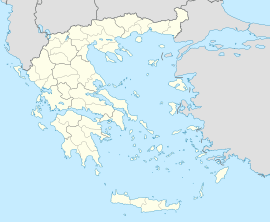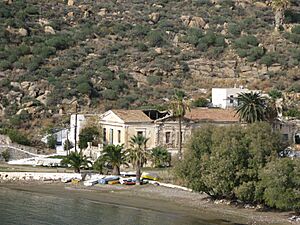Serifos facts for kids
Quick facts for kids
Serifos
Σέριφος
|
|
|---|---|

Airview
|
|
| Country | Greece |
| Administrative region | South Aegean |
| Regional unit | Milos |
| Area | |
| • Municipality | 75.21 km2 (29.04 sq mi) |
| Highest elevation | 585 m (1,919 ft) |
| Lowest elevation | 0 m (0 ft) |
| Population
(2021)
|
|
| • Municipality | 1,241 |
| • Municipality density | 16.500/km2 (42.736/sq mi) |
| Time zone | UTC+2 (EET) |
| • Summer (DST) | UTC+3 (EEST) |
| Postal code |
840 05
|
| Area code(s) | 22810 |
| Vehicle registration | EM |
| Website | www.serifos.gr |
Serifos (Greek: Σέριφος) is a beautiful Greek island in the Aegean Sea. It is part of a group of islands called the Cyclades. You can find Serifos south of Kythnos and northwest of Sifnos. It belongs to the Milos regional unit.
The island covers an area of about 75 square kilometers (about 29 square miles). In 2021, its population was 1,241 people. Serifos is located about 170 kilometers (106 miles) southeast of Piraeus, which is a big port city near Athens.
In Greek mythology, Serifos is famous for a special story. This is where Danaë and her baby son Perseus landed after being set adrift at sea. Later, when Perseus returned to Serifos, he used the head of the Gorgon Medusa to turn King Polydektes and his helpers into stone. This was a punishment for the king trying to force Perseus's mother to marry him.
Long ago, people used to joke that the frogs on Serifos couldn't make any noise! During the Roman Empire, Serifos was a place where people were sent away from their homes as punishment. After the year 1204, it became a small part of the Venetian dukes' lands. In the late 1800s, Serifos had a small economic boost because of its iron mines. These mines closed in the 1960s. Today, Serifos mostly relies on tourism and small-scale agriculture.
Early visitors to the island included British travelers Theodore and Mabel Bent in December 1883. Theodore Bent even started his 1885 travel book about the Cyclades with Serifos.
Contents
Exploring Ancient Serifos
If you look at the walls of the medieval castle in Chora, the main town, you can see old marble blocks. These blocks show that the ancient capital of Serifos was in the same spot. You can also see ancient marble sculptures found on the island at the Archaeological Collection in Chora. It is usually open from Tuesday to Sunday.
The most impressive ancient building is the Aspros Pýrgos, which means "White Tower." This marble watchtower was built around 300 BC. Its walls are still about 2 meters (6.5 feet) high, and it even has an inside staircase. The White Tower stands on a hilltop east of the road from Chora to Mega Livadi. Since 2011, experts have been studying the fallen stones to plan for its possible reconstruction.
Archaeologists have found at least four other ancient towers on the island. One of them is the large stone tower called Psaros Pyrgos. It is also known as the "Couch of the Cyclops" and is located in the southwest part of the island. Another site is the "Castle of the Old Lady" (Κάστρο της Γριάς) above Ganema and Koutalas. Here, you can still see small parts of an old stone building. Pieces of white marble, roof tiles, and old pottery found nearby suggest there might have been an ancient holy place here.
The fortified Monastery of the Taxiarchs is a special religious building. It is dedicated to the Archangels Michael and Gabriel and was built in 1572. It is just outside the village of Galani. For many years, Archimandrite Makarios has been the only monk living there, taking care of the monastery since 1958.
Churches Gallery: Sacred Places
Serifos Through Time: A Historical Journey
Ancient History of Serifos
The first settlers on Serifos were Ionians from Athens. Serifos was one of the few islands that bravely refused to surrender to Xerxes I, the Persian king. Later writers often mentioned Serifos as a poor and unimportant island. Because of this, the Roman emperors used it as a place to send criminals away from their homes.
It's interesting that ancient writers didn't mention the iron and copper mines on Serifos. These mines were definitely used in ancient times, as we can see from old traces. You might think these mines would have made the island richer. Even though ancient writers didn't talk about the mines, they did mention that the frogs of Serifos were different because they were silent!
Serifos in the Middle Ages
Serifos was part of the Byzantine Empire until 1204. After that, the island came under the rule of the Venetians. During this time, the mines on Serifos were reopened after being unused for about 1,000 years. In 1394, the miners even went on strike against their employer, Nikolaos Adoldos.
The Miners' Strike of 1916: A Fight for Rights
In the early 1900s, a company called "Société des mines de Seriphos-Spiliazeza" operated the mines on Serifos. A German expert named A. Grohmann was in charge. In the summer of 1916, the 460 miners decided to form a union and go on strike. They were unhappy with their low pay, very long working hours, and dangerous conditions. The company also refused to rehire workers who had served in the Greek army.
Their leader was Constantinos Speras, who was from Serifos. He had studied in Egypt and was an anarcho-syndicalist. This meant he believed in workers controlling their own workplaces and had experience with labor movements. Mr. Grohmann asked the Greek authorities for help. They sent 30 police officers from a nearby island.
The police arrested Speras and the strike leaders. The police lieutenant then ordered his men to shoot at the workers. The workers had gathered at the ore loading dock in Megalo Livadi and would not let a cargo ship be loaded. Four workers were killed, and about twelve were injured. The workers, with the help of their wives, fought back with stones. They killed three police officers and made the others retreat.
The freed leaders then took control of the island's services. They sent a message asking for protection from the French navy. However, the French navy did not get involved. A Greek warship soon arrived, and Speras was arrested. He was accused of treason, but he was released a few months later. Mr. Grohmann was given control of the mines again, but he had to agree to better working conditions and an 8-hour workday for the miners.
Serifos Population Over Time
| Year | Island population |
|---|---|
| 1981 | 1,133 |
| 1991 | 1,095 |
| 2001 | 1,414 |
| 2011 | 1,420 |
| 2021 | 1,241 |
Communities on Serifos
- Galani
- Kallitsos
- Koutalas
- Livadi Serifou
- Mega Chorio
- Mega Livadi
- Panagia
- Sykamia
- Serifos (town) or Chora
See also
 In Spanish: Serifos para niños
In Spanish: Serifos para niños














